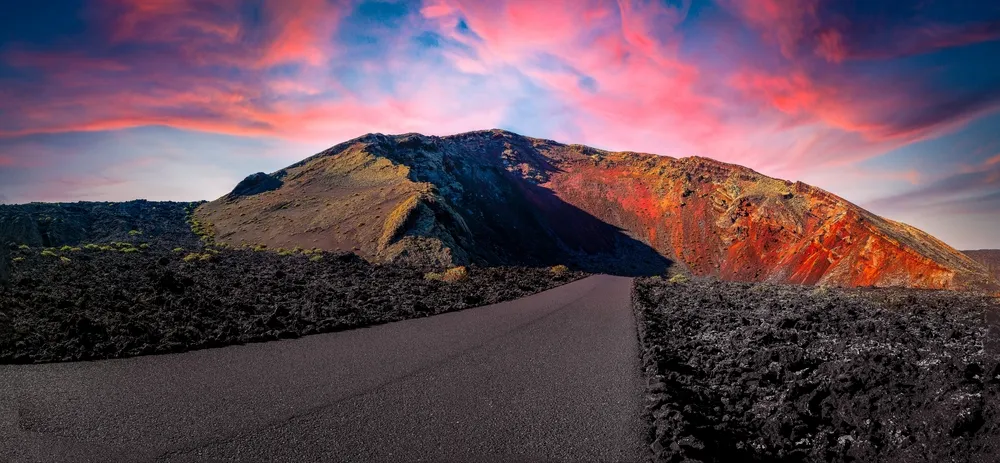
Explore the volcanic landscape of Lanzarote, the island of 1000 volcanoes.
Lanzarote, one of the Canary Islands, is renowned for its unique volcanic landscape. This extraordinary terrain, characterized by its rugged beauty, is a magnet for nature lovers, adventurers, and those curious about the powerful forces of nature.
In this article, we explore everything you need to know about the volcanoes of Lanzarote.
1. When did Lanzarote last erupt?
The last volcanic eruption in Lanzarote occurred in 1824. This eruption formed the volcanoes Tinguatón, Tao, and Volcán del Fuego, near Montañas del Fuego in the Timanfaya National Park. While the island's volcanic activity is considered dormant, it's important to note that there's always a possibility of future eruptions.
2. What makes Lanzarote's volcanic landscape unique?
Lanzarote's volcanic landscape is unlike any other place on Earth. The island's last major eruptions occurred between 1730 and 1736, followed by another in 1824. These eruptions created the stunning Timanfaya National Park, also known as "Montañas del Fuego" or "Mountains of Fire." The park covers over 51 square kilometers, with more than 100 volcanic cones and craters dotting the landscape.
The unique feature of Lanzarote's volcanoes is the variety of colors, textures, and forms. The solidified lava flows, ash fields, and volcanic craters create a surreal, almost lunar environment that is both awe-inspiring and eerie.
3. Which are the most famous volcanoes in Lanzarote?

- Timanfaya Volcano: The centerpiece of Timanfaya National Park, Timanfaya Volcano is the most famous on the island. It's still active, with temperatures just a few meters below the surface reaching up to 600 °C. Visitors can witness geothermal demonstrations and enjoy the unique experience of dining at the “El Diablo” restaurant, where food is cooked using the natural heat from the volcano.
- Caldera Blanca: Known for its vast, white crater, Caldera Blanca is one of the largest volcanic formations on the island. A popular hiking destination, it offers panoramic views of the surrounding landscape and is less crowded than Timanfaya.
- Montaña Colorada: This volcano is famous for its vibrant reddish hue, a result of iron oxidation. The hike around Montaña Colorada is relatively easy and provides an up-close look at volcanic bombs—large rocks ejected during eruptions.
4. Can you visit the volcanoes of Lanzarote?
Yes, visiting the volcanoes is one of the top activities in Lanzarote. Timanfaya National Park is the most accessible, with guided bus tours that take you through the most impressive volcanic areas. For a more immersive experience, consider taking a guided walking tour or a camel ride through the park.
Hiking enthusiasts can explore several other volcanic areas, such as Caldera Blanca and Montaña Colorada, at their own pace. While some trails are well-marked, it's advisable to go with a guide to fully appreciate the geological history and to stay safe.
5. What activities can you do in Timanfaya National Park?
- Geothermal demonstrations: Witness the raw power of nature with demonstrations showing how the volcanic heat just below the surface can ignite dry brush or create steam from water.
- El Diablo restaurant: Experience a meal cooked by the heat of the volcano at this unique restaurant, designed by renowned architect César Manrique.
- Guided bus tour: The “Ruta de los Volcanes” bus tour is the only way to explore the most delicate parts of the park. The tour takes you through a stunning landscape of craters, lava flows, and volcanic cones.
- Camel rides: For a different perspective, take a camel ride along the volcanic trails, offering a unique way to experience the stark beauty of the terrain.
6. How did the volcanic eruptions shape Lanzarote's culture?
The volcanic eruptions had a profound impact on Lanzarote’s culture. The barren, lava-covered land forced the islanders to innovate in agriculture, leading to the creation of unique farming techniques like "La Geria." In this area, grapevines are planted in shallow pits dug into the volcanic ash, protected by semi-circular stone walls. This method helps to retain moisture and protect the vines from the wind, producing some of the island's most famous wines, particularly the Malvasia variety.
The eruptions also inspired local art and architecture. César Manrique, a native of Lanzarote, drew inspiration from the island's volcanic landscape, incorporating natural elements into his designs. His works, such as the Jameos del Agua and Mirador del Río, are must-visit sites for those interested in the intersection of nature and creativity.
7. What is the best time to visit Lanzarote's volcanoes?
Lanzarote enjoys a mild climate year-round, making it an excellent destination to visit any time of the year. However, the best time to explore the volcanoes is during the cooler months from October to April. During this period, the temperatures are more comfortable for hiking and outdoor activities. The summer months, while still viable for a visit, can be quite hot, especially when exploring the volcanic terrain, which offers little shade.
8. Are there any safety precautions to consider when visiting Lanzarote’s volcanoes?
While Lanzarote's volcanoes are a sight to behold, visitors should take some precautions:
- Stay on marked trails: The volcanic landscape can be hazardous if you stray from designated paths. Lava fields can be uneven, and there may be hidden crevices.
- Sun protection: The volcanic landscape provides little natural shade, so wear sunscreen, a hat, and sunglasses to protect yourself from the sun.
- Hydration: Carry plenty of water, especially if you plan to hike. The volcanic terrain can be strenuous, and staying hydrated is essential.
- Footwear: Wear sturdy, comfortable shoes suitable for walking on rocky and uneven surfaces.
9. Is it safe to visit Lanzarote's active volcanoes?
Yes, it’s safe to visit Lanzarote's volcanoes. The island's last major eruption occurred in 1824, and while Timanfaya Volcano is still geothermally active, the area is closely monitored. The volcanic activity poses no immediate threat to visitors, and all tours and activities in the park are conducted under strict safety regulations.
10. Where to stay in Lanzarote?
The HD Beach Resort & Spa is a luxury all-inclusive resort located in Costa Teguise, Lanzarote. It offers a wide range of amenities, including spacious rooms with modern decor, a spa with a swimming pool, sauna, and jacuzzi, outdoor pools, restaurants and bars, and a variety of activities for guests of all ages. The resort is also conveniently located near the beach and offers easy access to other attractions on the island. It’s a popular choice for families and couples seeking a relaxing and enjoyable vacation.
Tour the island of volcanoes
Lanzarote's volcanoes offer a unique glimpse into the raw power of nature, where the dramatic landscape tells the story of the island's fiery past. Whether you're exploring Timanfaya National Park, hiking the Caldera Blanca, or simply marveling at the rugged terrain, Lanzarote’s volcanic wonders are a must-see. With this article, you're now ready to explore the island's most awe-inspiring natural attractions.





